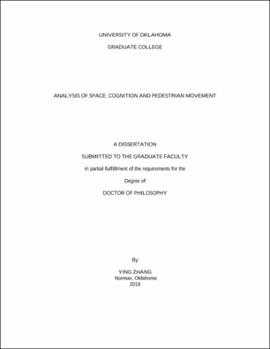| dc.description.abstract | Understanding the movement of people in urban areas is one of the most significant issues on spatial science with a wide range of applications in urban design, public health, public safety and intelligent transportation system. Urban planners, cognitive scientists, computer engineers, and geographers have contributed to an understanding of pedestrian movement from aspects of configurational analysis, knowledge representation, computational models, and space-time patterns respectively. However, no previous studies provide comprehensive solutions to pedestrian movement taking both space and cognition into account. Combining these disciplines allows us as researchers to not only explain correlations between spatial layouts and pedestrian flows but also understand how and why environmental perception and spatial knowledge are used by pedestrians to orient themselves and navigate through space.
My research proposes a theoretical framework of space, cognition and movement to fill in interdisciplinary gaps of pedestrian movement studies. The core of this framework lies in the hypothesis that where people choose to hold activities and how people choose to get there depends on individuals’ cognitive maps of the environment. This cognitive map consists of the salient layout of spatial features as well as the prominent utilities afforded by these features. The analysis proceeds from three dimensions: (1) space syntax to characterize spatial configuration or structure, (2) space semantics to address the distribution of activities, and (3) spatial cognition to capture one’s knowledge about the space.
The proposed framework was used to guide an empirical study conducted at the University of Oklahoma Norman Campus. Space was characterized by two aspects of space syntax and space semantics. For syntactical analysis, the study not only used measures of network centrality to examine network effects on pedestrian movement but also improved them by varying concepts of distance, adding distance decay effects, and weighting spatial heterogeneity of activities. Betweenness centrality calculated by the shortest length and weighted by distance decay effects resulted in the best description of observed pedestrian flows. In semantical analysis, functional centrality was described by density and diversity. Only functional density significantly contributed to modeling pedestrian flows. This study provided evidence that pedestrian movement depended on the spatio-functional interactions. The distribution of activities not only took the location advantage provided by spatial configuration but also reinforced network effects on pedestrian movement. This study not only examined aggregated patterns of pedestrian movement but also investigated individual variations in cognitive maps and wayfinding behaviors. The sketch map analysis suggested that as people became more familiar with the environment, the increase of completeness and accuracy was observed in their cognitive maps. Completeness was described by number of landmarks in sketch maps while accuracy concentrated on the relative positions between pairs of landmarks. Landmark served as the organizing concept of cognitive map. Betweenness centrality, functional density, and familiarity significantly contributed to modeling the presence of landmarks. When landmarks were used in navigation, this study developed a landmark-based pathfinding method. Landmark-based pathfinding resulted in a better description of routes selected by survey participants. In sum, individual cognitive maps, particularly the organization of landmarks, serve as the core in determining where pedestrians choose to hold activities and how to get there. Finally, the study developed the conceptual agent-based model (ABM) for pedestrian movement. The core of this ABM lies in a cognizing agent that is able to solve pathfinding tasks based on perceptual information and knowledge of cognitive map.
The research outcomes not only improve the understanding of spatial and cognitive factors on pedestrian wayfinding but also contribute to several disciplines. Architects and urban planners can adopt the framework of pedestrian movement to test, assess and improve existing spatial layouts and possible design alternatives. Computer scientists and Geographic Information System developers can use the specification of cognitive map to implement landmark based navigation system. Cognitive scientists and psychologists can apply the comprehensive model of pedestrian movement in research on human wayfinding behaviors for people with different perceptual abilities. | en_US |
